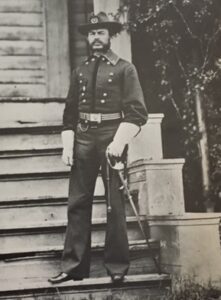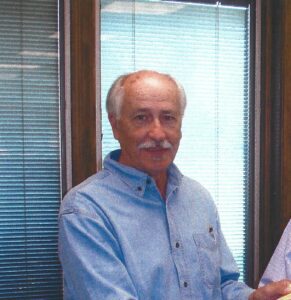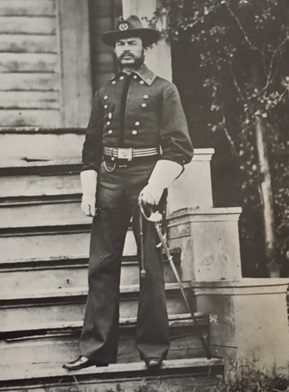

The Milford Museum will hold an opening for an exhibit of artifacts belonging to General A.T.A. Torbert donate by the Schelhouse family (Photo courtesy of Milford Museum)
The Milford Museum has announced that they will hold an opening for the new Alfred T.A. Torbert exhibit on March 21 at 5:00 PM . This exhibit is thanks to donations from the family of the late Marvin Schelhouse who was considered an expert on General Torbert.
“The family has generously donated many items that belonged to the general and his wife, Mary,” Claudia Leister, Executive Director of the museum, said. “The items include a beautiful goblet set, a music box that he likely brought from Paris where he served as United States Consul General for some time. The artifacts were collected over the years by Marvin and preserved beautifully.”
The museum closed the month of January in order to create special exhibit space for the artifacts. Some of the photos in the collection have never been seen before, including a wedding photo of the general and his wife.
“My interest in General Torbert began 55 years ago,” the late Schelhouse said in a presentation several years ago. “I I was 26 years old and a U.S. Marine. I had just returned from an overseas tour and was assigned to Quantico, Virginia. My wife and children eventually joined me at Quantico. One weekend, we wanted something to do, so we hopped in the car and went to Fredericksburg where we toured the battlefield and museums. When I got home, I called my mother and told her that I was interested in learning more about the Civil War after visiting Fredericksburg. My mother told me about a Civil War general who lived in Milford named General Torbert and I became fascinated.”
Born July 1, 1833 in Georgetown, Torbert was the son of Johnathan Robinson Torbert. His grandfather, William Torbert, was a wealthy merchant who lived in Camden. Torbert’s father took a job as a private tutor in Milton, teaching the children of Arthur Milby, instead of joining his father’s company and he married Catherine Milby in 1830. However, Johnathan was not as successful as his father. He and Catherine had ten children, starting with William in 1831 and Alfred in 1833. Five of their children died young. Catherine worked hard to keep up social appearances in order to disguise the financial difficulties the family faced, and this helped mold Alfred into a “southern gentleman” who was honest, chivalrous, social and with great integrity.
Torbert attended West Point after an appointment by Congressman George R. Riddle at the prompting of Judge E. Wooten of Georgetown. Initially, the congressman tried to get out of his original promise, but the judge knew the Torbert’s were poor and that Alfred held promise. Torbert served at West Point where Robert E. Lee was superintendent. His instructors became well-known during the Civil War, including Robert Garnett and William Walker who both died while fighting for the Confederacy as well as George Thomas and James B. McPherson who became Union Generals during the war. Classmates also became famous during the war, including J.E.B. Stuart, John B. Hood, Phil Sheridan, David Gregg and Harvey Slocum, some fighting for the north and others for the south.


Items in the exhibit were donated by the family of Marvin Schelhouse, considered an expert on General Torbert
After graduation, Torbert was stationed in Fort Clark, Texas. His father died in 1853 and his mother decided to move with Torbert’s sisters to Philadelphia. When the war began, Torbert was recruited for the Confederacy, but felt he should honor his commitment to the United States Army as a graduate of West Point.
“The United States government has given me an education and I should be a pretty disgraceful pupil if I used it against the country,” Torbert was quoted as saying.
Torbert was instrumental during the South Mountain campaign and also fought at Antietam as well as Fredericsburg. He fought in the Battle of Gettysburg as a Brigadier General and, while serving near Warrenton, Virginia, was promoted to Major General. He was even recognized by President Ulysses S. Grant while the president was reviewing the 6th Army Corps. An avowed horseman, President Grant commented that “Torbert rode a good horse,” high accolades from someone known for his prowess on horses.
Resigning his post after the war, Torbert moved to Milford where he married Mary E. Currey, the only child of Daniel Currey, a wealthy merchant and landowner. It is believed the two met while Torbert was mustering troops in New Jersey and Mary attended St. Mary’s Seminary. They built and lived in a beautiful home on North Walnut Street where they entertained frequently. Torbert served as president of the town council in what is now considered the mayor’s position. He was nominated for Congress in 1868, but lost. In 1869, he was appointed to the Republic of El Salvador as minister, but could not serve due to an outbreak of the malaria he contracted in Florida early in his career.
Torbert was appointed as Consul General to Havana in 1871 and then, in 1873, appointed as Consul-General to Paris where his wife joined him. It was in Paris that the Torbert’s entertained President and Mrs. Grant. After being replaced by future president Rutherford B. Hayes in 1878, the couple returned to Milford. While living in the stately home he and his wife built, Torbert was working with President Grant on a plan to develop railroad rights in Mexico.
On August 23, 1880, General Torbert left Milford and traveled to New York where he boarded a steamer, The City of Vera Cruz, which was bound for Mexico City. Off the coast of Georgia and Florida, the steamer encountered a hurricane on August 28, 1880. Instead of turning around or coming into port to ride out the storm, the steamer continued traveling. It broke up off the coast of Cape Canaveral, Florida.
“Survivors talked about General Torbert’s bravery,” Milford historian Dave Kenton said. “There are eyewitness accounts that Torbert went around spreading cheer and optimism as the hurricane reached its peak. He made an effort to save a small boy named Attridge before waves broke over the ship and swept him out to sea. The last person to see Torbert alive stated that he was bleeding from the cheek from a wound and had been washed from a small raft, exhausted.”
General Torbert’s body washed ashore August 30, 1880 alive, but all efforts to resuscitate him failed and he was pronounced dead at the age of 47. He was transported to Daytona, Florida, where he lay in state and was temporarily buried on September 1, 1880. He was exhumed and transported to New York, arriving September 29, 1880, where he was met by military escorts. Following a military funeral at Trinity Church in New York, a special train transported his body to Philadelphia, Wilmington and finally, Milford.
“His funeral was one of the largest ever held in Milford,” Kenton said. “Governor John Wood Hall, Senator Willard Saulsbury, Judges Wooten and John Houston plus every prominent person in Kent and Sussex County were in attendance. The procession traveled to the corner of Church Street where Reverend J. Leighton McKim gave the burial service. The body was carried to its tomb in the Old Methodist Cemetery on North Street and, while the militia fired a burial salute, General Torbert’s wife threw herself on his grave and had to be pulled back. The service continued and Mrs. Torbert broke free again, throwing herself on her husband’s grave. According to close friends of the family, it was one of the most distressing funerals ever attended.”
In 1969, a decision was made to demolish the Torbert home to make room for the bank parking lot. According to Kenton, Schelhouse wrote a letter to local legislators asking them to intercede and protect the home. He was being sent to Vietnam as a Marine and could not remain behind to fight to save the home of the general who he revered so greatly. He learned as he traveled overseas that the home had been demolished. A plaque now stands on the corner of the parking lot where the stately Torbert house once stood. In a strange twist of fate, Schelhouse was living in a home just prior to his death that belonged to the Torbert family.
“Marvin wanted to restore a home that was historic,” Kenton said. “He purchased a home in Georgetown and had it moved to Milford. It was only later he learned that the home was the Milby home where General Torbert spent time in his youth. Much of the furnishings in the home now owned by the Schelhouse’s were accumulated by the Torbert’s while they were in Paris.”
Not only did Schelhouse save the childhood home of Torbert as well as artifacts that belonged to the general, one whose name had never been mentioned when he was in school, even though he was considered a hero, he decided to give him the recognition he deserved. Schelhouse began doing extensive research and made the decision to have a statue erected in town in honor of General Torbert. Schelhouse reached out to Kenton for assistance and the two men raised $90,000, an amount unheard of at the time, to erect the statue on the property of the Milford Museum, one that still stands today.
The public is welcome to attend the opening of the exhibit and there will be refreshments available.
Share this Post



